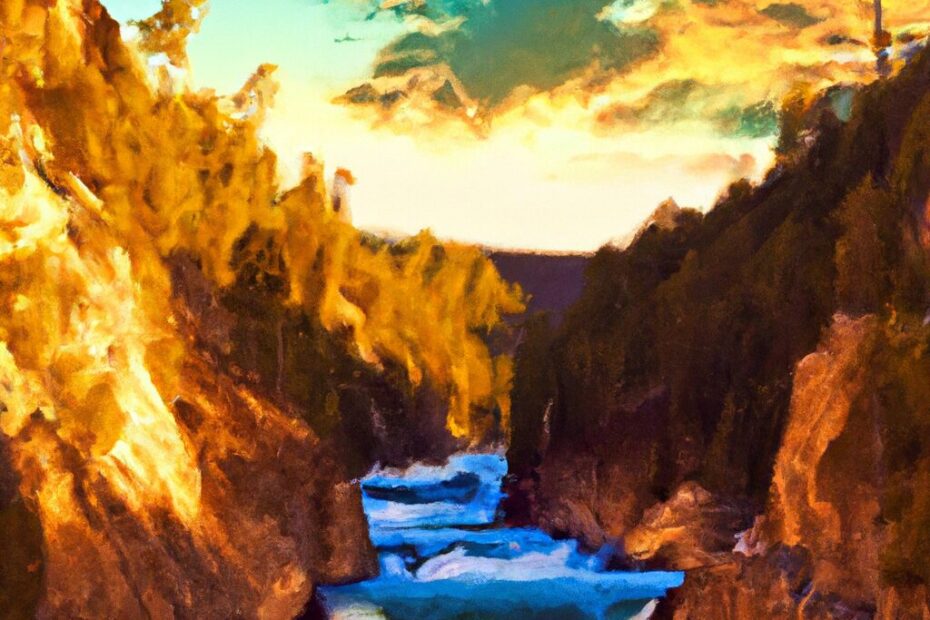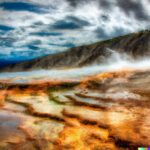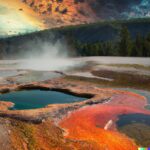Have you ever wondered about the mysterious geothermal features that make Yellowstone National Park so unique? From bubbling hot springs to erupting geysers, the park is home to some of the most fascinating natural wonders on Earth.
In this article, we will explore the formation of geothermal features, the specific types found in Yellowstone, and what makes them so special. We will also discuss the potential dangers of these features and provide tips for safely experiencing them during your visit. So, let’s dive in and uncover the secrets of Yellowstone’s geothermal wonders!
What Are Geothermal Features?
Geothermal features are natural phenomena that occur in thermal pools and hydrothermal areas, showcasing the unique aspects of geothermal systems and the diverse range of geothermal phenomena.
Geothermal features, such as hot springs, geysers, and fumaroles, are a result of the Earth’s underground heat interacting with rock formations. These features are known for their high temperature, mineral-rich waters, and vibrant colors due to microbial life.
Aside from their natural beauty, geothermal resources also play a crucial role in renewable energy production. By harnessing the Earth’s core heat, they provide electricity and heating for various purposes, promoting sustainable development and reducing reliance on fossil fuels.
How Are Geothermal Features Formed?
Geothermal features are formed through a combination of volcanic activity, geologic formations, and the activity of hydrothermal vents, often hosting heat-loving microorganisms that contribute to their unique formations and characteristics.
The volcanic activity plays a crucial role in providing the initial source of heat necessary for the formation of geothermal features. As magma rises towards the surface, it heats up water and rocks, creating the conditions for geysers, hot springs, and fumaroles to develop.
Geologic formations such as faults and fractures also influence the emergence of these features, providing pathways for the circulation of water and the release of heat. Hydrothermal vents release hot, mineral-rich water into the surrounding environment, where heat-loving microorganisms, known as thermophiles, thrive. These microorganisms contribute to the unique chemical compositions and colors often observed in geothermal features, adding to their distinct characteristics.
Where is Yellowstone National Park?
Yellowstone National Park, located primarily in the U.S. states of Wyoming, Montana, and Idaho, is renowned for its diverse geothermal attractions and its unique environment characterized by hydrothermal areas.
The park’s geological landscape features hot springs, geysers, mud pots, and fumaroles, attracting visitors with its vibrant displays of natural hydrothermal activity. Its distinct environment also includes colorful microbial mats and thermophilic bacteria thriving in the extreme conditions, contributing to the park’s ecological significance.
The park’s location atop the Yellowstone Caldera, one of the largest supervolcanoes in North America, adds to its geological importance, making it an unparalleled natural wonder for both scientists and nature enthusiasts.
What Are the Geothermal Features in Yellowstone National Park?
Yellowstone National Park boasts a diverse array of geothermal features, including iconic geysers, natural hot springs, fumaroles, bubbling mud pots, and spectacular steam vents that captivate visitors with their unique displays.
These geothermal wonders are a testament to the park’s volcanic activity. Geysers, such as the famous Old Faithful, erupt in powerful jets of steam and water at regular intervals, creating remarkable spectacles.
Hot springs, on the other hand, are known for their vibrant colors, caused by microorganisms and mineral deposits. Fumaroles emit steam and gases, often accompanied by a distinct sulfuric odor. Mud pots bubble and gurgle, showcasing the interaction between water, gas, and volcanic rock, while steam vents release plumes of steam, adding to the park’s otherworldly ambiance.
Geysers
The geysers in Yellowstone National Park are among the most captivating thermal features, showcasing the park’s geothermal wonders with their mesmerizing eruptions and distinctive formations.
Their eruptions, often reaching impressive heights, create a spectacle that draws visitors from around the world.
The vivid colors of the hot springs and the intricate patterns of the mineral formations add to the allure, forming a surreal landscape against the park’s natural backdrop.
These thermal wonders provide a glimpse into the Earth’s powerful forces, showcasing the interconnectedness of geology and nature, making them prominent attractions within Yellowstone National Park.
Hot Springs
The hot springs of Yellowstone National Park create a stunning geothermal landscape, displaying vibrant colors and intricate silica deposits that contribute to their remarkable beauty and significance.
These captivating features are the result of geological processes that have been shaping the park for thousands of years. The presence of vibrant colors in the hot springs is attributed to the diverse types of thermophilic bacteria and algae thriving in the extreme conditions.
The formation of silica deposits around the pools adds to their otherworldly appearance, as the mineral-rich water interacts with the surrounding rock formations. This unique combination of geological phenomena makes Yellowstone’s hot springs an integral part of the park’s mesmerizing natural wonder.
Fumaroles
Fumaroles within Yellowstone National Park contribute to the park’s unique geothermal environment, often hosting heat-loving microorganisms and showcasing the dynamic interactions between the Earth’s geothermal processes and microbial life.
Fumaroles, which release steam and gases from volcanic activity, have a significant impact on the diverse microbial communities that thrive in these extreme conditions.
The intense heat and chemical-rich environment surrounding fumaroles create a habitat for thermophilic bacteria, archaea, and other microorganisms that have adapted to these challenging conditions.
Studying the relationship between fumaroles and microbial life offers valuable insights into the complex dynamics of Yellowstone’s geothermal ecosystem.
Mud Pots
The mud pots of Yellowstone National Park represent fascinating geothermal phenomena, characterized by bubbling mineral-rich mud and the deposition of unique mineral formations, creating a spectacle of natural wonder within the park.
The mud pots found in Yellowstone National Park are a result of its extensive geothermal activity. Hot water and steam interact with the earth’s crust, creating vibrant mineral-rich mud. As minerals continuously deposit over time, intriguing features like colorful mud streaks and sculpted mud mounds form, adding to the park’s distinctive landscape.
The unique combination of geothermal activity and mineral deposits make the mud pots an essential aspect of the park’s geological wonders.
Steam Vents
The steam vents in Yellowstone National Park serve as vivid illustrations of the park’s geothermal resources, showcasing the dynamic nature of hydrothermal systems and the impact of geothermal processes on the surrounding landscape.
Yellowstone National Park is home to some of the most stunning natural wonders on the planet. These breathtaking features not only provide a feast for the eyes, but they also play a crucial role in maintaining the delicate balance of the park’s ecosystem.
The steam vents found throughout the park are particularly fascinating. These vents release a combination of water vapor and gases, such as carbon dioxide and hydrogen sulfide, which are essential components of the park’s hydrothermal features. They also offer valuable insights into the Earth’s geologic processes, giving researchers a glimpse into the powerful forces at work beneath the surface.
For visitors, the steam vents are a must-see attraction. The otherworldly sights and sounds emanating from these vents are truly captivating, making them an integral part of the Yellowstone experience. So be sure to add them to your itinerary when you visit this incredible national park.
What Makes Yellowstone National Park’s Geothermal Features Unique?
The geothermal features of Yellowstone National Park stand out for their status as geothermal wonders, creating unique landscapes and serving as captivating geothermal attractions that hold immense significance within the park’s natural environment.
The park’s geothermal wonders, such as the iconic Old Faithful geyser, showcase the incredible power and beauty of natural geothermal activity. These features have played a crucial role in shaping the park’s exceptional landscapes, with vibrant hot springs, bubbling mud pots, and stunning terraces.
Visitors are drawn to these prominent geothermal attractions not only for their visual appeal but also for their contribution to scientific research on geothermal processes and their importance in environmental conservation efforts.
Largest Collection of Geysers in the World
Yellowstone National Park boasts the largest collection of geysers in the world, displaying unique formations and holding immense geothermal value as a globally significant geothermal site.
These geysers are a testament to the park’s rich geological history and provide a glimpse into the Earth’s immense natural energy resources. The iconic Old Faithful, with its predictable eruptions, has drawn millions of visitors to witness the power of geothermal activity.
Beyond its scenic beauty, the geysers play a crucial role in scientific research, contributing to our understanding of geothermal processes and their potential for sustainable energy production. This makes Yellowstone National Park a key global hub for geothermal studies and an invaluable natural resource for future energy sustainability.
Unique Colors and Formations
The geothermal features of Yellowstone National Park are characterized by unique colors and formations, underscoring their significance as captivating elements within the park’s expansive geothermal landscape.
Boiling pools of vivid turquoise, vibrant orange terraces, and the rich earthy reds of mud pots create a stunning kaleidoscope of hues amidst the park’s diverse geological wonders.
These captivating features not only showcase the raw power of nature but also serve as a testament to the complex and dynamic forces at work beneath the surface of Yellowstone’s iconic landscape.
Constantly Changing Landscape
The geothermal features of Yellowstone National Park contribute to a constantly changing landscape, reflecting the dynamic nature of geothermal phenomena and their wider significance within the park’s natural environment.
It is fascinating to witness how the geothermal activity shapes the park’s terrain, forming captivating features such as geysers, hot springs, and fumaroles. These geothermal phenomena not only create visually stunning landscapes but also play a crucial role in maintaining the delicate ecological balance of the area.
The striking colors and textures of the geothermal pools and terraces stand as a testament to the powerful forces operating beneath the surface, constantly altering and rejuvenating the park’s surface. Visitors can experience firsthand the awe-inspiring effects of these geothermal wonders, reminding us of the profound influence of nature on our planet’s varied landscapes.
What Are the Dangers of Geothermal Features?
Geothermal features pose inherent dangers such as high temperatures, the release of toxic gases, and the presence of unstable ground, requiring caution and awareness when venturing near these natural phenomena.
Geothermal areas can be dangerous due to high temperatures and toxic gases emitted, such as hydrogen sulfide. These can cause severe burns and even be lethal if inhaled in large quantities. Additionally, the unstable ground can lead to unexpected collapses or sinkholes, adding to the risk. It is crucial for visitors to follow warning signs and safety guidelines to avoid potential hazards.
High Temperatures
The high temperatures associated with geothermal features can present significant impacts on the surrounding environment, posing potential risks to both visitors and the natural ecosystem.
Such elevated temperatures can lead to alteration of the natural landscape, affecting vegetation and wildlife.
The release of sulfurous gases and other geothermal emissions may contribute to air and water pollution, impacting the ecosystem.
The risk of accidental burns or heat-related incidents for visitors is a concern in areas with geothermal activity.
It’s crucial for authorities to implement safety measures and educate the public about the potential dangers associated with these unique natural phenomena.
Toxic Gases
The release of toxic gases from geothermal features necessitates measures for preservation and conservation, as these emissions can have adverse effects on both the environment and human health.
Geothermal energy is a renewable source that produces emissions, such as sulfur dioxide and hydrogen sulfide. These emissions can contribute to air pollution and acid rain. Additionally, prolonged exposure to these toxic gases can pose serious health risks to nearby communities and ecosystems.
It is essential to implement effective preservation efforts and conservation strategies to minimize the environmental and health impacts of geothermal gas emissions. This emphasizes the importance of comprehensive monitoring and mitigation measures to protect the well-being of the environment and human populations.
Unstable Ground
The presence of unstable ground near geothermal features requires effective management strategies to ensure visitor safety and the preservation of the natural landscape, warranting careful attention and planning.
It is crucial to address the potential risks associated with unstable ground, as the geothermal features attract numerous visitors seeking to witness the natural wonders.
The implementation of comprehensive management strategies, including clear signage, designated viewing areas, and ongoing monitoring, can mitigate these risks. Emphasizing visitor education on the importance of respecting safety protocols and the fragile nature of the environment is essential.
Balancing the protection of the natural landscape with providing a memorable experience for visitors is a delicate yet vital aspect of managing these unique geological features.
How Can Visitors Safely View and Experience Geothermal Features?
Visitors can safely view and experience geothermal features by adhering to park regulations, staying on designated trails, being aware of warning signs, and seeking information from knowledgeable park rangers.
This ensures the preservation of the natural beauty and the safety of both visitors and the delicate ecosystem. By following these guidelines, visitors can appreciate the unique geothermal wonders while minimizing their impact on the environment.
Park regulations are in place to protect the geological formations and prevent accidents. Staying on designated trails not only ensures personal safety but also prevents damage to fragile vegetation. Being attentive to warning signs is crucial as they indicate potential hazards. Seeking advice from park rangers can provide valuable insights and enhance the overall experience.
Follow Park Regulations
Adherence to park regulations is crucial for ensuring visitor safety and the conservation of geothermal features. These guidelines are designed to protect both the natural environment and those exploring it.
By following these regulations, visitors can help minimize their impact on delicate ecosystems and ensure that future generations can continue to enjoy these natural wonders. These guidelines play a vital role in safeguarding geothermal features from damage caused by human interference, preserving them for the enjoyment of all. Adhering to park regulations also contributes to the overall sustainability of the park, promoting responsible and respectful interaction with the environment.
Stay on Designated Trails
Staying on designated trails is essential for ensuring visitor safety and fostering geothermal awareness. It minimizes the risks associated with venturing near potentially hazardous geothermal features.
By adhering to these marked paths, visitors not only safeguard themselves but also contribute to the preservation of delicate geothermal ecosystems.
Oftentimes, the surrounding terrain in geothermal areas can be unstable. Veering off designated trails can disturb fragile geological formations or lead to accidental encounters with scalding hot springs or unpredictable geysers. This conscientious practice also aids in the protection of rare and specialized flora and fauna that thrive in the unique conditions near geothermal features, thereby promoting ecological conservation and sustainable tourism.
Be Aware of Warning Signs
Being aware of warning signs near geothermal features is imperative for ensuring visitor safety and understanding the wider significance of potential hazards within the natural environment.
This awareness is crucial as geothermal areas can pose significant dangers due to the unpredictable nature of the features.
Understanding and heeding these warning signs not only protect visitors but also fosters a deeper appreciation for the delicate balance of natural forces.
It is vital for visitors to recognize that the seemingly tranquil beauty of geothermal areas can mask potential risks, and adherence to warning signs is a responsible and respectful approach to enjoying these natural wonders.
Seek Information from Park Rangers
Seeking information from knowledgeable park rangers enhances visitor safety and provides valuable insights into the educational aspects of geothermal features, fostering a deeper understanding of the park’s unique natural phenomena.
The rangers at our park have a deep understanding of geothermal processes, including hot springs, geysers, and fumaroles. This allows them to provide informative and engaging educational programs that showcase the geological significance and environmental impact of these natural wonders.
Through their knowledge, rangers help visitors connect with the park’s rich geothermal history and understand its role in the ecosystem. This plays a vital role in promoting geothermal education and fostering a sense of stewardship towards these delicate natural resources.
Frequently Asked Questions
What are the geothermal features in Yellowstone National Park?
Yellowstone National Park is famous for its geothermal features, which include geysers, hot springs, mud pots, and fumaroles. These features are a result of the park’s location on top of a supervolcano, which creates heat and pressure that causes the geysers and other features to erupt.
What is the most famous geothermal feature in Yellowstone National Park?
The most famous geothermal feature in Yellowstone National Park is Old Faithful geyser. This geyser erupts regularly and is one of the most predictable geysers in the park, making it a popular attraction for visitors.
Are there any dangers associated with the geothermal features in Yellowstone National Park?
Yes, there are potential dangers associated with the geothermal features in Yellowstone National Park. The hot springs and geysers can reach extremely high temperatures and are not safe for swimming or soaking. It is important to stay on designated boardwalks and follow all safety signs and instructions to avoid accidents.
What causes the bright colors in the geothermal features of Yellowstone National Park?
The bright colors in the geothermal features of Yellowstone National Park are caused by thermophilic (heat-loving) bacteria. These bacteria thrive in the hot, mineral-rich water and create vibrant colors that add to the park’s unique beauty.
Can you visit the geothermal features year-round in Yellowstone National Park?
Yes, you can visit the geothermal features year-round in Yellowstone National Park. While some roads and trails may be closed during the winter months, there are still plenty of opportunities to see and experience the geothermal features. Just make sure to dress appropriately for the colder temperatures.
Are there any guided tours available for the geothermal features in Yellowstone National Park?
Yes, there are guided tours available for the geothermal features in Yellowstone National Park. These tours are led by knowledgeable park rangers and can provide valuable information and insights about the geothermal features and their importance in the park’s ecosystem. It is recommended to book these tours in advance, especially during peak tourist seasons.
Last Updated on January 25, 2024 by Jon Waraas – Originally Posted: January 25, 2024

I’m Jon Waraas, and I’ve been navigating the online world since 2006. By day, I’m the proud owner of some eCommerce gems, and by night, I’m the voice behind the adventures on Waraas.Com.
My heart, however, belongs to the wild beauty of Yellowstone National Park. I’ve got a collection of websites dedicated to sharing the wonders of this natural masterpiece. Oh, and did I mention? I’m currently building my own cabin inside the ghost town of Gilmore, Idaho – a cabin with tales to tell!
When I’m not immersed in the digital realm, you’ll find me lacing up my boots for a good hike or setting up camp under the star-studded sky.




